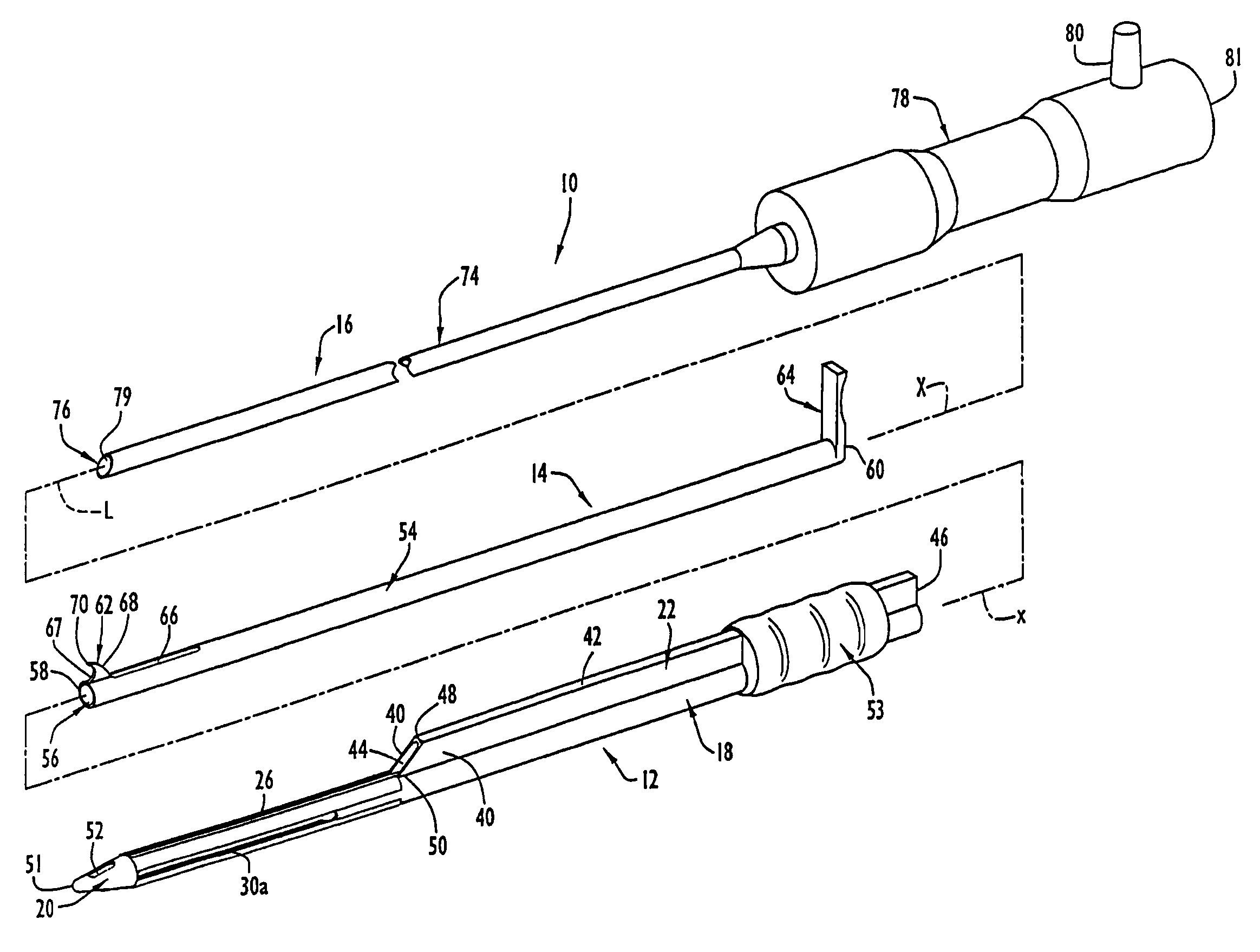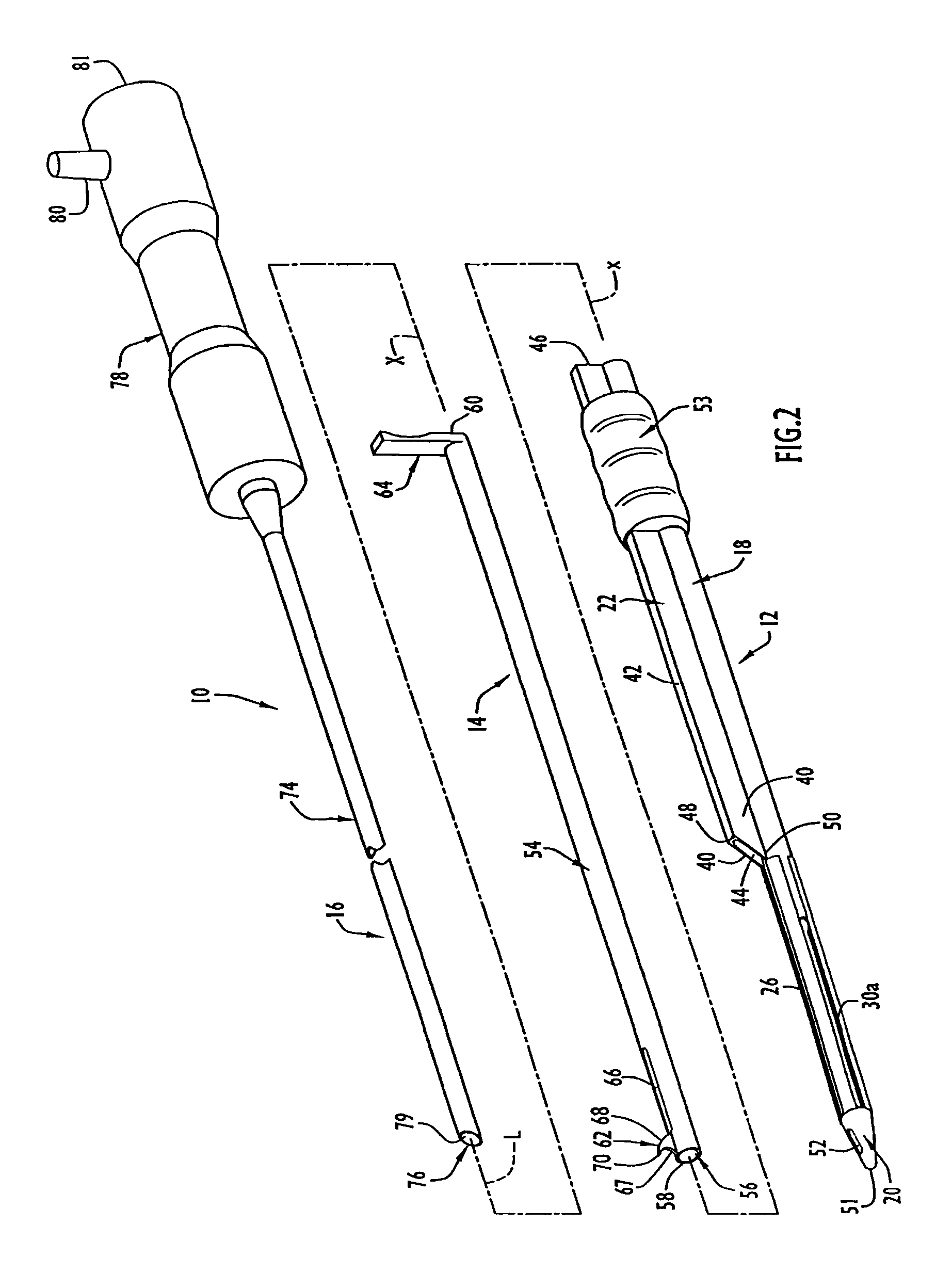Non-surgical treatments for
carpal tunnel syndrome, including rest, immobilization and anti-inflammatory medications, are not successful in relieving symptoms in a high percentage of cases.
There are many drawbacks to open
surgical procedures for carpal tunnel release including considerable post-operative pain,
increased risk of infection, long
recovery times in which use of the hand is greatly curtailed, the need for the patient to wear immobilizing devices such as splints, unsightly scarring, loss of grip and pinch strength, the potential for inadvertent injury to nearby
anatomical structures such as the palmar cutaneous nerve, and losses due to missed work.
The drawbacks associated with open carpal tunnel release
surgery tend to be exacerbated in procedures involving palmar incisions on account of the highly specialized and sensitive nature of the
skin and anatomical tissue in the area of the palm.
However, any incision in the
wrist at or too close to a flexion crease is undesirable.
Incisions that cross a flexion crease may result in undesirable complications including undesired tension on the incision line and
hypertrophic scar formation.
Incisions at or too close to a flexion crease also result in greater pain for the patient due to this area being an anatomical joint subjected to frequent movement.
Although the “short scar” technique lessens the scar morbidity, it decreases the ability to visualize key anatomic landmarks during the procedure.
However, such procedures typically involve “blind” cutting of the transverse carpal
ligament, thusly presenting a greater risk of inadvertent injury to nearby important
anatomical structures as well as the risk that the transverse carpal
ligament will not be completely severed.
Moreover, in
surgical procedures where a deep incision, even a transverse one, is made in the volar aspect of the
wrist through the
skin and underlying tissue, there is still a heightened risk of inadvertent injury and other complications for the patient because of the specialized and sensitive important
anatomical structures and tissue in this area of the wrist.
Despite the benefits of minimally invasive or endoscopic procedures, prior instruments and methods for endoscopic carpal tunnel release have all too frequently resulted in various complications including injury to the superficial palmar arch,
tendon lacerations, nerve injuries, incomplete release of the transverse carpal ligament, recurrence of symptoms, hematomas, and
reflex sympathetic dystrophy.
In many prior methods of endoscopic carpal tunnel release, the median nerve cannot be identified endoscopically with confidence or certainty, thereby creating reluctance on the part of many surgeons to perform carpal tunnel release as a minimally
invasive procedure despite the benefits to be derived therefrom.
Since the
endoscope is not introduced until after formation of the incision,
insertion of the obturator into the carpal tunnel and then
insertion of the sheath into the carpal tunnel, the Okutsu et al procedure involves blind
insertion of various instruments into the carpal tunnel and presents various opportunities for unintentional injury to critical anatomical structures before endoscopic
visualization is established.
It is thusly difficult to control the depth of the
cut as well as the cutting location on the ligament.
Given the small size of the carpal tunnel, even small positional deviations of the instruments risk injury to important anatomical structures.
Furthermore, the need to move two separate instruments, i.e. the knife and the
endoscope, independently but at the same time makes execution of the Okutsu et al procedure awkward and difficult as well as increases the potential for positional deviations of the instruments.
In addition, it is difficult in the Orr procedure, and in other procedures that utilize a cannula or sheath of uniformly round external cross-section, to maintain alignment of the knife with a desired cutting location on the ligament because the uniformly round external cross-section of the cannula makes it especially prone to rotate.
Despite the knife blade being contained in the slot while cutting the ligament, the lack of positional control over the instruments makes the cutting performed in the Orr procedure very similar to freehand cutting.
However, since the entire probe is moved from distal to proximal for each cutting movement or pass, it is difficult to return the probe to its previous distal position in order to obtain an endoscopic view of the
cut already made in the ligament and / or to continue the cutting movement along the previously established cutting line.
The
instrumentation provided by Agee et al is bulky, difficult to maneuver with precision or accuracy, and provides limited endoscopic visualization through the
lateral aperture of the probe.
The Mirza procedure is disadvantageous for its blind insertion of instruments, its limited field of endoscopic view prior to, during and subsequent to the cutting procedure, the need for insertion and withdrawal of many instruments, the lack of protection for the knife blade as the scope is distally advanced within the cannula prior to actual cutting, and the need for securement of the hand in
hyperextension.
In addition, even a small size palmar incision is undesirable given the specialized nature of the palmar tissue and the presence of critical anatomical structures in the area of the palm.
Undesirable complications may ensue
in patient's with internal anatomical anomalies, such as unusual
anatomical location of the superficial palmer arch
artery or unusual positioning of the motor
branch of the median nerve.
Moreover, given the small
confined space in which critical anatomical structures are located in the wrist, undesirable complications may result where the instruments deviate even a small amount from the prescribed path.
Because the hand is secured in
hyperextension, the median nerve and other important anatomical structures are at
increased risk of injury since they too are held in an immovable position.
Furthermore, it is difficult in the Chow procedure to accurately position each of the several cutting instruments at the proper location so that each of the separately formed cuts in the ligament combine to form a continuous complete
cut through the ligament.
Additional drawbacks of the Chow procedure are that two portals are required and these are undesirably located in the volar aspect of the wrist and in the specialized tissue of the palm.
In the Chow procedure as well as in other endoscopic procedures that utilize an incision in the palm and / or an incision in the volar aspect of the wrist, the location(s) of the incision(s) gives rise to various disadvantages including increased pain and longer
recovery times for the patient, higher risk of inadvertent injury to the patient, and greater risk of complications.
The need for multiple separate cuts and cutting instruments in order to effectuate a complete cut of the transverse carpal ligament in the Chow procedure increases the cost of
instrumentation for the procedure and also extends the duration of the procedure.
Surgical procedures of longer duration translate into greater cost but even more importantly place the patient at greater risk.
In discussing the Chow procedure, Miller et al and Resnick et al consider it a drawback of the Chow procedure to retract the flexor tendons toward the radial side after incising the volar antebrachial
fascia to
expose the flexor tendons.
Miller et al and Resnick et al believe that retraction of the flexor tendons places undue traction upon both the ulnar and median neurovascular structure and results in an increased incidence of postoperative median and ulnar nerve neuropraxiae.
In addition, Miller et al and Resnick et al believe that the Chow procedure places the ulnar neurovascular structures at risk by requiring deep
dissection into the carpal tunnel.
In reality, the cannula / obturator
assembly is “walked” under the ligament in essentially a blind fashion due to the limited field of direct view distal to the
assembly and due to there being no provision for endoscopic visualization at this point in the procedure.
In addition to blind insertion of the cannula / obturator
assembly through the carpal tunnel, the procedures described by Miller et al and Resnick et al have many of the same disadvantages as the Chow procedure.
The procedure is therefore performed blindly up to this point and gives rise to the disadvantages associated with blind entry into the carpal tunnel and blind insertion of instruments therein.
Like some of the other endoscopic procedures discussed above, the Brown procedure is disadvantageous not only for its blind procedural steps but also for its palmar and wrist incisions, its need for separate instruments to be introduced in opposite ends of the cannula, its lack of positional control over the instruments in the carpal tunnel and over the cutting location on the transverse carpal ligament, its limited field of endoscopic view, and its need for simultaneous movement of the knife and the
endoscope from opposite ends of the cannula.
The insertion of instruments in the subligamentous plane between the transverse carpal ligament and the
flexor tendon synovium sheath in endoscopic carpal tunnel release procedures is made more difficult due to the fact that wrist
anatomy imparts an upward slope to the subligamentous plane in the distal direction.
Conventional dilators and other conventional instruments used to enter the carpal tunnel in prior endoscopic carpal tunnel release procedures have distal end configurations which make it difficult to guide the instruments to follow the upward slope of the subligamentous plane.
When these instruments are forwardly or distally advanced toward or beneath the transverse carpal ligament in a straight horizontal path or plane, the instruments commonly become obstructed, snagged or trapped in or by the synovium.
In addition to increasing the complexity of the procedure and inflicting trauma on the patient, instruments that are obstructed, snagged or trapped by or in the synovium provide a poor vantage point for reliable endoscopic visualization of anatomical structures in the carpal tunnel because the
clarity of the
endoscopic image viewed through the synovium is distorted or impaired.
Furthermore, some of the synovium will remain attached to the underside of the transverse carpal ligament which impairs endoscopic visualization of the ligament and the ability to identify the ligament with confidence.
 Login to View More
Login to View More  Login to View More
Login to View More 


